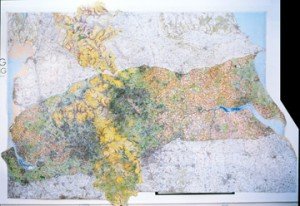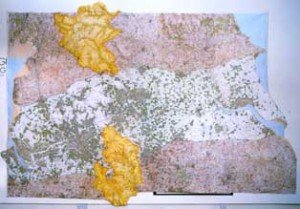Casting a Green Net: Can it Be We are Seeing a Dragon?
This work of art, formed of word/image/narrative, embodying a conceptual design for making the Transpennine area of North England more self-sustaining, proposes a transformation that will permit bio-diversity and cultural diversity to co-evolve across the Pennines to each other’s advantage. The Dragon image virtually rhymes the estuaries of the Mersey at Liverpool and the Humber at Hull in a manner that will identify, enlarge and attempt to connect the multitude of fragmented, biodiverse or potentially biodiverse sites from Liverpool to Hull, across the Pennines, thereby fashioning a green net stretching across the mid-Pennine area of North England, between the estuary of the Mersey and the estuary of the Humber. The work proposes to connect, and in some places construct anew, these fragmented sites to insure the ecological value of the natural heritage of biodiversity in the very diverse topographies, soils, and climate conditions that exist in what amounts to be a passage across the Pennines from Liverpool to Hull averaging thirty five miles in width and one hundred and ten miles in length.
The concept of the “Green Net” also encompasses ideas that support the development of economic diversity, social and cultural diversity as well as biodiversity. In “the Dragon”, these diversities are layered, mutually interdependent, potentially re-enforcing, operating as the sub-stratum that permits such a net to exist at all.
The story is expressed in five maps, each about three meters by four and a half meters. Beginning as ordinance maps of North England, reworked so that the roads drop back; with rivers, mountains, and urban patterns, accentuated. The area is bounded east and west by the coastline; above and below the estuaries of the Humber and the Mersey respectively, north by the Roman Roads to the north of Manchester and Leeds; and south by the Roman Road that ran through Chester.
These boundaries encompass about nine million people living in cities, towns, villages and hamlets of remarkable variety.
Are We Seeing A Dragon?
When the estuaries, and parts of the coastlines of the Mersey and the Humber, are drawn bold to the west and east, respectively; when the Roman Road crossing the Pennine coast to coast, one north, the other southward.
When the Peak District Park to the south is also drawn, as is the outlying Pennine Park to the north. The overall drawing of this enclosure has remarkable properties.
An astonishing image emerges, reading as an awkward strangely shaped dragon in flight, with a lake for its eye. Its head is at Hull, pointing east to Denmark and the Baltic Sea. Its tail is slightly curled at the estuary of the Mersey, but pointing west to the Irish Sea and the Atlantic. The possibility for new patterns suddenly becomes visible. Within this flying dragon image, these patterns suggested that a new multi-leveled gestalt is available, encompassing culture in its broadest sense; urban, agricultural, economic, geological, and of course, ecological values. From this vision comes the title of this work, Are we Seeing a Dragon?
We call such an image such as this, when it appears, a sustainability icon since it serves to delineate a pathway to sustainability; an emergent new history capable of expressing an overall ecology of place.
Designed for the exhibition Art Transpennine. The installation was exhibited first in the Bluecoat Gallery in Liverpool, thereafter in the Aachen Museum of International Art, Aachen Germany and at Ronald Feldman Fine Arts in New York. Catalog.
Where: Great Britain
When: 1996-1998
Who: Harrison Studio Britain
Project Manager: David Haley



